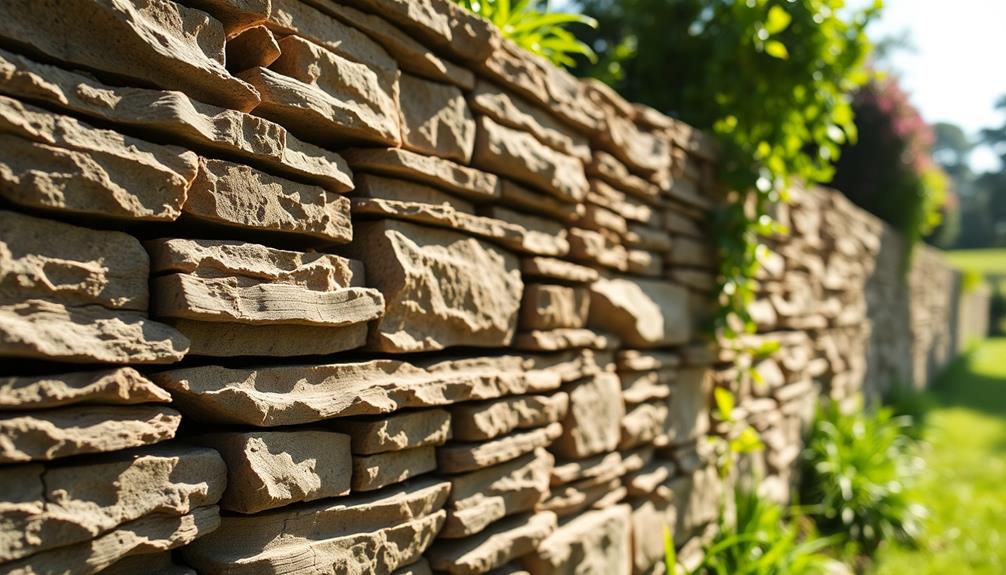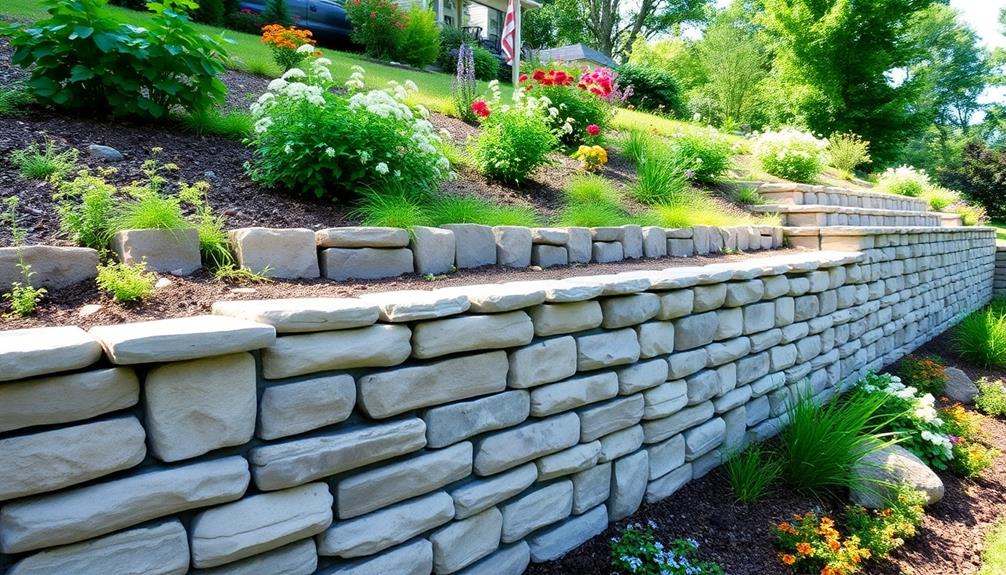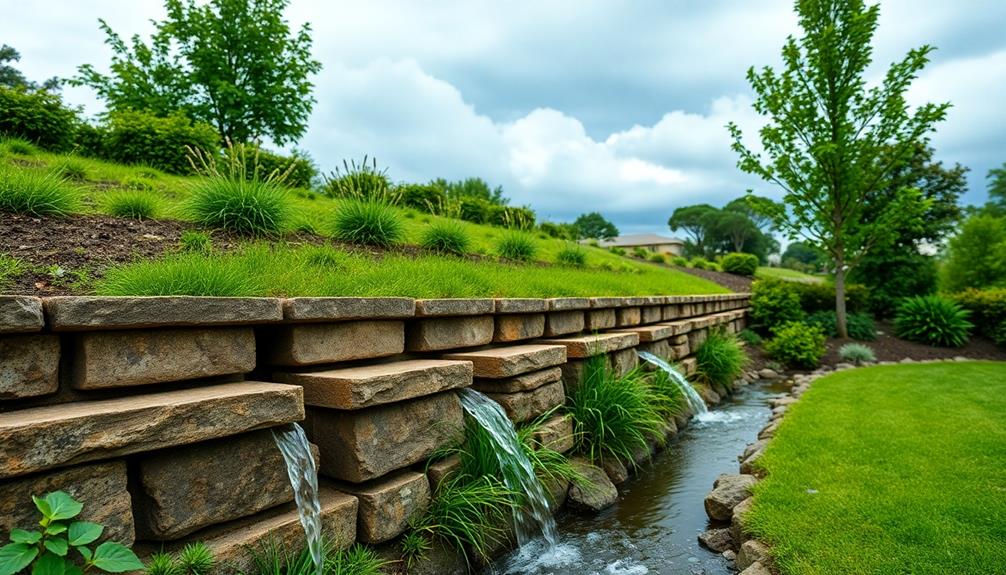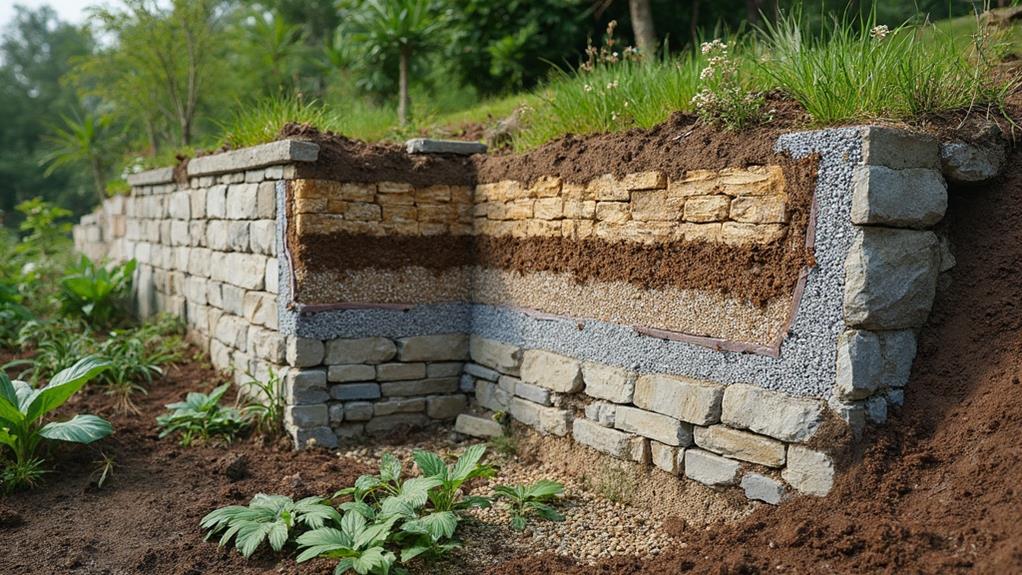Proper construction techniques for retaining walls are essential to guarantee their long-term stability and functionality. These techniques incorporate a robust understanding of lateral pressures and forces, crucial for designing walls that can withstand environmental stresses while effectively supporting landscapes. By emphasizing sound design principles, such as appropriate drainage systems and foundation stability, these constructions mitigate erosion risks and integrate harmoniously with the environment. Selecting durable and weather-resistant materials, while also maintaining aesthetic consistency with the surrounding area, further enhances these structures' effectiveness. Understanding these elements can reveal the significant impact proper construction has on landscape integrity and property value.
Table of Contents
ToggleWalls Contractor Highlights
- Proper construction ensures stability and prevents collapse of retaining walls under lateral soil pressure.
- Effective techniques maximize wall longevity and minimize costly repairs and maintenance.
- Appropriate construction prevents soil erosion and maintains landscape integrity.
- Proper drainage solutions mitigate hydrostatic pressure that can lead to wall failure.
- Quality construction fosters community trust by enhancing safety and reliability.
Definition of Retaining Walls

Retaining walls serve a pivotal role in landscaping by providing both aesthetic appeal and functional support to prevent soil erosion and manage hilly terrains. These structures are underpinned by sound structural design principles, which guarantee stability and durability under various environmental conditions.
The selection of materials is a critical aspect, requiring consideration of factors such as load-bearing capacity, weather resistance, and integration with the surrounding landscape to optimize the wall's performance and longevity. Constructed walls, particularly boulder retaining walls, excel in holding ground over the long term, boosting curbside charm, and allowing creative as well as architecturally sound designs.
Purpose in Landscaping
Serving both functional and aesthetic roles, retaining walls are indispensable structures in landscaping. These engineered barriers perform the critical task of holding back soil and water, preventing erosion and landslides.
In addition to their practical utility, retaining walls also offer versatility in transforming uneven or sloped grounds into usable spaces, thereby expanding landscaping possibilities. By creating terraced levels, they maximize the availability of flat areas for planting, seating, or other landscape features, forging a seamless blend between nature and designed environments.
Beyond their structural prowess, retaining walls greatly enhance the aesthetic appeal of outdoor spaces. By introducing vertical dimensions, they contribute to the visual dynamism of the landscape, enabling homeowners and designers to create distinct zones and focal points.
Materials such as stone, timber, or concrete imbue these walls with texture and color that complement the natural surroundings and architectural elements. Additionally, they present opportunities for integrating additional landscape features such as stairs, pathways, or planters, fostering a sense of harmony and cohesion.
Ultimately, through careful design and placement, retaining walls play a pivotal role in landscaping, balancing functionality with beauty, and crafting environments that feel both cultivated and connected.
Structural Design Principles
When planning the construction of retaining walls, understanding the fundamental structural design principles is essential to guarantee their stability and effectiveness. Retaining walls are engineered structures designed primarily to stabilize soil and mitigate erosion, functioning as a pivotal component in terrain alteration and landscape architecture. These structures must be meticulously designed to withstand the lateral pressures imposed by the retained material, requiring a profound comprehension of forces acting upon them, such as gravity, soil pressure, and surcharge loads.
The integrity of a retaining wall is largely dependent on its ability to resist sliding, overturning, and bearing capacity failures. It is crucial to account for wall geometry, including height and thickness, which directly influence its load-bearing capabilities. Additionally, incorporating drainage solutions is indispensable to alleviate hydrostatic pressure, as water accumulation can gravely compromise structural integrity.
Equally important is establishing a robust foundation, which serves as the wall's pivotal support, requiring site-specific analysis of soil properties and stability. By integrating these principles into the design process, one can forge a structurally sound retaining wall that not only fulfills its intended purpose but also harmonizes with the surrounding environment, aligning with both aesthetic and functional objectives.
Material Selection Criteria
While the structural design principles lay the foundation for retaining wall stability, selecting appropriate materials is equally critical to guarantee durability and functionality. Material selection involves a thorough evaluation of several factors, including environmental conditions, aesthetic requirements, and load-bearing capacity. The selection process should be meticulous, as the performance of a retaining wall hinges upon the intrinsic properties of the chosen materials, alongside their compatibility with the surrounding landscape and climate conditions.
Criteria for material selection start with considering the type of soil and expected load, which dictate the wall's strength requirements. Materials must also exhibit resistance to environmental stressors like water and temperature fluctuations, ensuring longevity without frequent maintenance. Concrete, natural stone, and treated wood are common choices, each offering distinct advantages and drawbacks. For instance, concrete blocks provide excellent structural integrity and weather resistance, whereas natural stone offers timeless aesthetics and blends seamlessly with natural surroundings.
Furthermore, sustainability is an increasingly important criterion, encouraging the use of locally sourced and environmentally friendly materials. Ultimately, thoughtful material selection actively contributes to a sense of belonging in the community by harmonizing built structures with the natural environment and societal values.
Benefits

Retaining wall construction offers multifaceted benefits that substantially enhance a property's functionality and appearance. By bolstering structural stability and curbing soil erosion, these retaining walls are instrumental in protecting landscapes from the adverse effects of shifting earth and weather conditions.
Concurrently, these walls can create usable areas for gardening or patios. Additionally, retaining walls can greatly improve a property's aesthetic appeal and, in turn, increase its market value, making them a wise investment for both residential and commercial properties.
Enhanced Structural Stability
Achieving enhanced structural stability in retaining wall construction offers numerous advantages that substantially extend the lifespan and functionality of these critical structures. When investing in a retaining wall, one entrusts it with the vital role of maintaining landscape integrity and supporting diverse environmental needs.
Enhancing stability through adept construction techniques not only guarantees the wall's steadfast resilience under various pressures but also nurtures a shared confidence among community members who rely on its dependable performance. Such assurance fosters a sense of belonging, as individuals collectively benefit from a structure built with enduring durability.
A structurally sound retaining wall incorporates engineering precision and material quality, essential for resisting external forces such as thrust from earth and hydrostatic pressure. By employing techniques such as proper drainage systems, adequate foundational reinforcement, and the strategic use of geosynthetic materials, professionals can ensure that these walls not only stand firm but seamlessly integrate within their landscaped surroundings.
The resulting longevity minimizes maintenance issues and reduces replacement frequency, affirming the community's trust and investment. Through the amalgamation of thoughtful design and robust construction, retaining walls become more than mere barriers; they transform into enduring symbols of security and commitment to shared spaces.
Prevents Soil Erosion
Incorporating construction techniques that emphasize structural stability not only guarantees enduring durability but also effectively addresses one of the most pressing environmental concerns—soil erosion. A well-engineered retaining wall acts as a formidable barrier against natural forces that might otherwise strip away valuable topsoil from your landscape. This not only preserves the integrity of your property but also fosters an environmentally conscious commitment in your community.
A collective awareness of the following benefits can inspire shared goals for sustainable living:
- Mitigation of Runoff Water: Properly built retaining walls channel rainwater efficiently, reducing surface runoff and minimizing erosion.
- Enhanced Plant Growth: Retained soil retains moisture and nutrients longer, promoting healthier plant development.
- Preservation of Land Value: Erosion control helps maintain the land's usability, ensuring continued satisfaction in property investments.
- Reduction of Environmental Impact: By preventing soil displacement, retaining walls protect nearby water bodies from sediment pollution.
These benefits create a framework through which individuals collectively work to achieve aesthetic and environmental synergy in their neighborhoods. Retaining walls serve as essential partners in landscape design, anchoring outdoor spaces with both functional advantages and a symbolic investment in sustainable stewardship.
Improves Aesthetic Appeal
In the domain of landscape architecture, a well-crafted retaining wall can transform an ordinary outdoor space into an aesthetically pleasing environment. This transformation is not merely functional but also visually enriches the setting, providing a canvas for creativity and style that resonates with the desire for beauty and harmony within a community. Proper construction techniques are paramount in achieving this aesthetic appeal, guaranteeing that the wall integrates seamlessly with its surroundings while offering structural integrity.
Attention to detail in materials, design, and execution allows retaining walls to serve as more than just functional barriers; they become focal points that draw the eye and enhance the overall landscape. By incorporating natural stone, textured concrete, or landscaping blocks, a well-designed retaining wall can reflect personal tastes or regional styles, creating a sense of belonging and continuity with the terrain. The choice of materials, combined with thoughtful design, can evoke certain moods—ranging from rustic charm to modern elegance.
Furthermore, skillful construction ensures that dimensions, proportions, and alignment elevate the space's beauty, allowing it to flow into the broader environment naturally. Meticulously built retaining walls not only serve their primary purpose but also contribute significantly to the aesthetic cohesion of any landscape.
Increases Property Value
While enhancing both functionality and aesthetics, a well-constructed retaining wall can considerably increase property value. By providing more usable space, improving drainage, and reinforcing structural integrity, these walls offer a tangible return on investment. Homeowners seeking to create an inviting and well-maintained landscape that resonates with prospective buyers will find that a properly executed retaining wall sets a property apart, often commanding a premium price on the market.
A retaining wall's ability to enhance property value is not just theoretical but is evident in several key aspects such as:
- Enhanced Usable Land: Many properties contain uneven or sloped terrain, and retaining walls transform these areas into functional living or gardening spaces.
- Improved Aesthetics: A skillfully designed wall adds a visual anchor and can be used to delineate specific areas of interest, such as patios or flower beds.
- Structural Support: Properly constructed walls prevent soil erosion, aiding in maintaining the landscape's integrity over time, reducing maintenance costs for the owner.
- Increased Curb Appeal: These walls offer an elegant design element that can make a significant impression on potential buyers at first glance.
In creating an appealing, durable, and versatile outdoor environment, a retaining wall guarantees both improved living space and long-term property value enhancement.
Prevent Water Accumulation Issues

Effective retaining wall construction requires addressing potential water accumulation issues that could otherwise impede the wall's integrity. Guaranteeing suitable drainage mechanisms is pivotal not only to avoid structural damage but also to promote soil stability, thereby prolonging the wall's lifespan. Below is a table highlighting critical strategies in this regard:
| Strategy | Benefit |
|---|---|
| Install proper drainage | Avoid structural damage |
| Use of geotextiles | Promote soil stability |
| Incorporate weep holes | Confirm effective drainage |
Implementing these strategies helps maintain the wall's functionality and aesthetic appeal.
Ensure Effective Drainage
A critical aspect of retaining wall construction is guaranteeing proper drainage to prevent water accumulation, which can undermine the wall's stability and lifespan. Effective drainage designs protect against hydrostatic pressure, which can lead to structural failures. Proper drainage systems mitigate risks by channeling water away from the wall, preserving its structural integrity.
Incorporating drainage elements can be achieved through various strategies:
- Gravel and Perforated Pipes: Including a layer of gravel behind the wall along with perforated drainage pipes allows water to escape efficiently, reducing pressure buildup.
- Weep Holes: For additional water relief, small openings within the wall, known as weep holes, facilitate the exit of moisture, minimizing potential stress.
- Slope and Landscape Design: Proper grading ensures that water flows away from the retaining wall, preventing pooling that could compromise its base.
- Waterproof Membranes: Applying waterproof layers behind the wall inhibits moisture ingress, safeguarding against saturation and associated damage.
These drainage solutions not only contribute to the longevity of the retaining structure but also aid in fostering a sense of security and belonging among community members who rely on the steadfastness of such constructions. By thoroughly addressing drainage, one reinforces the retaining wall's role as a resilient and enduring part of the landscape.
Avoid Structural Damage
Numerous factors can contribute to structural damage in retaining walls, with water accumulation being one of the most significant threats. This issue arises when water permeates the soil behind the wall, increasing pressure that can lead to instability and eventual failure. The proper design and installation of drainage systems are indispensable to mitigating this risk, as they effectively direct water away, reducing hydrostatic pressure exerted behind the wall.
Incorporating weep holes and drainage pipes allows for efficient water redirection, ensuring that any accumulated moisture is swiftly evacuated. Additionally, the use of free-draining backfill material can enhance water movement away from the structure. Such methods not only extend the longevity of the wall but also strengthen the collective integrity of the surrounding landscape.
Attention to detail during the construction phase is essential in avoiding pitfalls that may compromise the wall's durability. Materials must be carefully selected and spacing of drainage elements must be meticulously calculated to match site-specific conditions. Implementing these strategies cultivates a sense of reliability and resilience in the built environment, fostering an inclusive community atmosphere where individuals can share in the continuous trust and support that well-constructed infrastructure provides.
Promote Soil Stability
To maintain soil stability in retaining wall construction, managing water accumulation is essential. Improper water drainage can lead to soil erosion, ultimately compromising the structural integrity of retaining walls. Accordingly, implementing effective water management strategies is not merely a recommendation but a necessity for the longevity and stability of these structures, which serve not only aesthetic but functional purposes within a landscape.
Drainage Systems: Incorporate perforated pipes and gravel backfill to facilitate the efficient movement of water away from the wall's foundation, reducing hydrostatic pressure.
Grading: Ensure the surrounding terrain is appropriately sloped to direct water away from the retaining wall, preventing pooling and soil saturation.
Waterproof Membranes: Apply waterproofing materials to the wall's rear to protect against moisture penetration and reduce the risk of water-induced erosion.
Regular Maintenance: Routine inspections and maintenance of drainage features help in identifying any potential blockages or failures before they evolve into significant issues.
For those involved in the construction or supervision of retaining walls, mastering these techniques assures not only compliance with engineering standards but also aligns with an overarching commitment to fostering resilient and safe community spaces where people feel secure and connected.
Walls Contractor FAQ
How Long Do Retaining Walls Typically Last With Proper Maintenance?
Retaining walls, when constructed and maintained with diligence, generally have a lifespan of 50 to 100 years. This longevity underscores the importance of community-focused practices, where shared commitment to maintenance fosters enduring structures and collective environmental responsibility.
What Materials Are Best for Constructing Retaining Walls?
Selecting durable materials is pivotal for retaining walls. Options such as concrete, stone, and treated timber offer stability and longevity, fostering a sense of community security by ensuring structural integrity and aesthetics for shared landscapes and properties.
Can Retaining Walls Be Used on Sloped Landscapes?
Retaining walls are indispensable for sloped landscapes. They offer stability and prevent soil erosion, securing your property's value and aesthetic. Proper implementation fosters community pride and guarantees safety, aligning with shared goals of enhancing environmental resilience and harmony.
How Can Vegetation Affect the Integrity of a Retaining Wall?
Vegetation can influence the integrity of a retaining wall by introducing root systems which may exert pressure or cause soil erosion. Properly planned inclusion of plant life can enhance wall aesthetics while ensuring structural stability and longevity.
Are Permits Required for Building Retaining Walls in Residential Areas?
Permits are often required for building retaining walls in residential areas to guarantee compliance with local regulations and safety standards. Adhering to permitting processes fosters community safety, enhancing our shared responsibility for secure and harmonious living environments.







